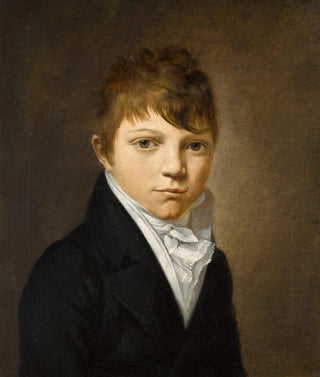Art print | Portrait of a young boy - Louis Léopold Boilly


View from behind

Frame (optional)
Portrait of a Young Boy - Louis Léopold Boilly – Captivating Introduction
In the fascinating world of art, some works manage to capture the very essence of childhood with such intensity that they transcend time. The "Portrait of a Young Boy" by Louis Léopold Boilly is one of these creations. Created in the early 19th century, this painting evokes a delicacy and psychological depth that invite the viewer to delve into the inner universe of the young child depicted. Through his gaze, Boilly offers us a window into a bygone era, a culture, but above all, into a soul. This portrait, both in its composition and its treatment of colors, embodies the art of classical portraiture while also foreshadowing the beginnings of Romanticism.
Style and uniqueness of the work
Boilly's style is distinguished by his ability to blend realism and sensitivity. In this portrait, the young boy is depicted with meticulous precision, every detail of his face and attire carefully crafted. Light plays a leading role, gently illuminating the child's features and creating a striking contrast with the dark background. This chiaroscuro technique, mastered by the artist, gives an almost lifelike dimension to the figure, as if it were about to come to life. The nuances of color, ranging from warm tones to cooler shades, add visual richness that draws the eye and stimulates the imagination. Furthermore, the boy's expression, both gentle and pensive, evokes an immediate emotional connection, prompting the viewer to wonder about his thoughts and dreams.
The artist and his influence
Louis Léopold Boilly, an emblematic figure of French painting, made a name for himself through his exceptional talent and unique artistic vision. Born in 1761, he evolved within a rapidly changing artistic context, between Neoclassicism and Romanticism. Boilly was able to capture the aspirations and concerns of his time, while developing a personal style that was entirely his own. His work, rich in portraits and scenes of everyday life, bears witness to a keen observation of human nature. Boilly's impact on his contemporaries and subsequent generations is ind

Matte finish

View from behind

Frame (optional)
Portrait of a Young Boy - Louis Léopold Boilly – Captivating Introduction
In the fascinating world of art, some works manage to capture the very essence of childhood with such intensity that they transcend time. The "Portrait of a Young Boy" by Louis Léopold Boilly is one of these creations. Created in the early 19th century, this painting evokes a delicacy and psychological depth that invite the viewer to delve into the inner universe of the young child depicted. Through his gaze, Boilly offers us a window into a bygone era, a culture, but above all, into a soul. This portrait, both in its composition and its treatment of colors, embodies the art of classical portraiture while also foreshadowing the beginnings of Romanticism.
Style and uniqueness of the work
Boilly's style is distinguished by his ability to blend realism and sensitivity. In this portrait, the young boy is depicted with meticulous precision, every detail of his face and attire carefully crafted. Light plays a leading role, gently illuminating the child's features and creating a striking contrast with the dark background. This chiaroscuro technique, mastered by the artist, gives an almost lifelike dimension to the figure, as if it were about to come to life. The nuances of color, ranging from warm tones to cooler shades, add visual richness that draws the eye and stimulates the imagination. Furthermore, the boy's expression, both gentle and pensive, evokes an immediate emotional connection, prompting the viewer to wonder about his thoughts and dreams.
The artist and his influence
Louis Léopold Boilly, an emblematic figure of French painting, made a name for himself through his exceptional talent and unique artistic vision. Born in 1761, he evolved within a rapidly changing artistic context, between Neoclassicism and Romanticism. Boilly was able to capture the aspirations and concerns of his time, while developing a personal style that was entirely his own. His work, rich in portraits and scenes of everyday life, bears witness to a keen observation of human nature. Boilly's impact on his contemporaries and subsequent generations is ind






